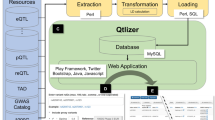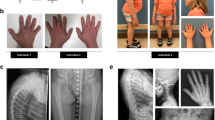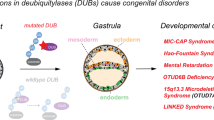Abstract
Desbuquois dysplasia (DBQD) is an autosomal recessive skeletal disorder characterized by growth retardation, joint laxity, short extremities, and progressive scoliosis. DBQD is classified into two types based on the presence (DBQD1) or absence (DBQD2) of characteristic hand abnormalities. CANT1 mutations have been reported in both DBQD1 and DBQD2. Recently, mutations in the gene encoding xylosyltransferase 1 (XYLT1) were identified in several families with DBQD2. In this study, we performed whole-exome sequencing in two Turkish families with DBQD2. We found a novel and a recurrent XYLT1 mutation in each family. The patients were homozygous for the mutations. Our results further support that XYLT1 is responsible for a major subset of DBQD2.
Similar content being viewed by others
Log in or create a free account to read this content
Gain free access to this article, as well as selected content from this journal and more on nature.com
or
References
Bonafe, L., Cormier-Daire, V., Hall, C., Lachman, R., Mortier, G., Mundlos, S. et al. Nosology and classification of genetic skeletal disorders: 2015 revision. Am. J. Med. Genet. A 167, 2869–2892 (2015).
Huber, C., Oulès, B., Bertoli, M., Chami, M., Fradin, M., Alanay, Y. et al. Identification of CANT1 mutations in Desbuquois dysplasia. Am. J. Hum. Genet. 85, 706–710 (2009).
Faivre, L., Cormier-Daire, V., Eliott, A. M., Field, F., Munnich, A., Maroteaux, P. et al. Desbuquois dysplasia, a reevaluation with abnormal and ‘normal’ hands: radiographic manifestations. Am. J. Med. Genet. A 124A, 48–53 (2004).
Kim, O., Nishimura, G., Song, H., Matsui, Y., Sakazume, S., Yamada, M. et al. A variant of Desbuquois dysplasia characterized by advanced carpal bone age, short metacarpals, and elongated phalanges : report of seven cases. Am. J. Med. Genet. A 152A, 875–885 (2010).
Furuichi, T., Dai, J., Cho, T., Sakazume, S., Ikema, M., Matsui, Y. et al. CANT1 mutation is also responsible for Desbuquois dysplasia, type 2 and Kim variant. J. Med. Genet. 48, 32–37 (2011).
Bui, C., Huber, C., Tuysuz, B., Alanay, Y., Bole-Feysot, C., Leroy, J. G. et al. XYLT1 mutations in desbuquois dysplasia type 2. Am. J. Hum. Genet. 94, 405–414 (2014).
Jamsheer, A., Olech, E. M., Kozłowski, K., Niedziela, M., Sowińska-Seidler, A., Obara-Moszyńska, M. et al. Exome sequencing reveals two novel compound heterozygous XYLT1 mutations in a Polish patient with Desbuquois dysplasia type 2 and growth hormone deficiency. J. Hum. Genet. 61, 577–583 (2016).
Silveira, C., Leal, G. F. & Cavalcanti, D. P. Desbuquois dysplasia type II in a patient with a homozygous mutation in XYLT1 and new unusual findings. Am. J. Med. Genet. A 170, 3043–3047 (2016).
Prydz, K. & Dalen, K. T. Synthesis and sorting of proteoglycans. J. Cell Sci. 113, 193–205 (2000).
Nakajima, M., Mizumoto, S., Miyake, N., Kogawa, R., Iida, A., Ito, H. et al. Mutations in B3GALT6, which encodes a glycosaminoglycan linker region enzyme, cause a spectrum of skeletal and connective tissue disorders. Am. J. Hum. Genet. 92, 927–934 (2013).
Nakajima, J., Okamoto, N., Tohyama, J., Kato, M., Arai, H. & Funahashi, O. De novo EEF1A2 mutations in patients with characteristic facial features, intellectual disability, autistic behaviors and epilepsy. Clin. Genet. 87, 356–361 (2015).
Mckenna, A., Hanna, M., Banks, E., Sivachenko, A., Cibulskis, K., Kernytsky, A. et al. The Genome Analysis Toolkit : A MapReduce framework for analyzing next-generation DNA sequencing data. Genome Res. 20, 1297–1303 (2010).
Wang, K., Li, M. & Hakonarson, H. ANNOVAR : functional annotation of genetic variants from high-throughput sequencing data. Nucleic Acids Res. 38, 1–7 (2010).
Miyatake, S., Tada, H., Moriya, S., Takanashi, J., Hirano, Y., Hayashi, M. et al. Atypical giant axonal neuropathy arising from a homozygous mutation by uniparental isodisomy. Clin. Genet. 87, 395–397 (2015).
Schreml, J., Durmaz, B., Cogulu, O., Keupp, K., Beleggia, F., Pohl, E. et al. The missing ‘link’: an autosomal recessive short stature syndrome caused by a hypofunctional XYLT1 mutation. Hum. Genet. 133, 29–39 (2014).
Miyake, A., Nishimura, G., Futami, T., Ohashi, H., Chiba, K., Toyama, Y. et al. A compound heterozygote of novel and recurrent DTDST mutations results in a novel intermediate phenotype of Desbuquois dysplasia, diastrophic dysplasia, and recessive form of multiple epiphyseal dysplasia. J. Hum. Genet. 53, 764–768 (2008).
Zhang, D., Herring, J. A., Swaney, S. S., McClendon, T. B., Gao, X., Browne, R. H. et al. Mutations responsible for Larsen syndrome cluster in the FLNB protein. J. Med. Genet. 43, e24 (2006).
Unger, S., Lausch, E., Rossi, A., Mégarbané, A., Sillence, D., Alcausin, M. et al. Phenotypic features of carbohydrate sulfotransferase 3 (CHST3) deficiency in 24 patients: congenital dislocations and vertebral changes as principal diagnostic features. Am. J. Med. Genet. A 152A, 2543–2549 (2010).
Hästbacka, J., de la Chapelle, A., Mahtani, M. M., Clines, G., Reeve-Daly, M. P., Daly, M. et al. The diastrophic dysplasia gene encodes a novel sulfate transporter: positional cloning by fine-structure linkage disequilibrium mapping. Cell 78, 1073–1087 (1994).
Vissers, L. E., Lausch, E., Unger, S., Campos-Xavier, A. B., Gilissen, C., Rossi, A. et al. Chondrodysplasia and abnormal joint development associated with mutations in IMPAD1, encoding the Golgi-resident nucleotide phosphatase, gPAPP. Am. J. Hum. Genet 88, 608–615 (2011).
Acknowledgements
We thank the patients and their families for their help to the study. We also thank N Atsumi for checking English. This study is supported by research grants from the Japan Agency For Medical Research and Development (AMED) (contract no. 14525125).
Author information
Authors and Affiliations
Corresponding author
Ethics declarations
Competing interests
The authors declare no conflict of interest.
Additional information
Supplementary Information accompanies the paper on Journal of Human Genetics website
Rights and permissions
About this article
Cite this article
Guo, L., Elcioglu, N., Iida, A. et al. Novel and recurrent XYLT1 mutations in two Turkish families with Desbuquois dysplasia, type 2. J Hum Genet 62, 447–451 (2017). https://doi.org/10.1038/jhg.2016.143
Received:
Revised:
Accepted:
Published:
Issue date:
DOI: https://doi.org/10.1038/jhg.2016.143
This article is cited by
-
Novel compound heterozygous variants in XYLT1 gene caused Desbuquois dysplasia type 2 in an aborted fetus: a case report
BMC Pediatrics (2022)
-
Cloning, expression and enzyme activity delineation of two novel CANT1 mutations: the disappearance of dimerization may indicate the change of protein conformation and even function
Orphanet Journal of Rare Diseases (2020)
-
Recapitulating the human segmentation clock with pluripotent stem cells
Nature (2020)
-
The clinical and mutational spectrum of B3GAT3 linkeropathy: two case reports and literature review
Orphanet Journal of Rare Diseases (2019)
-
Dysosteosclerosis is also caused by TNFRSF11A mutation
Journal of Human Genetics (2018)



